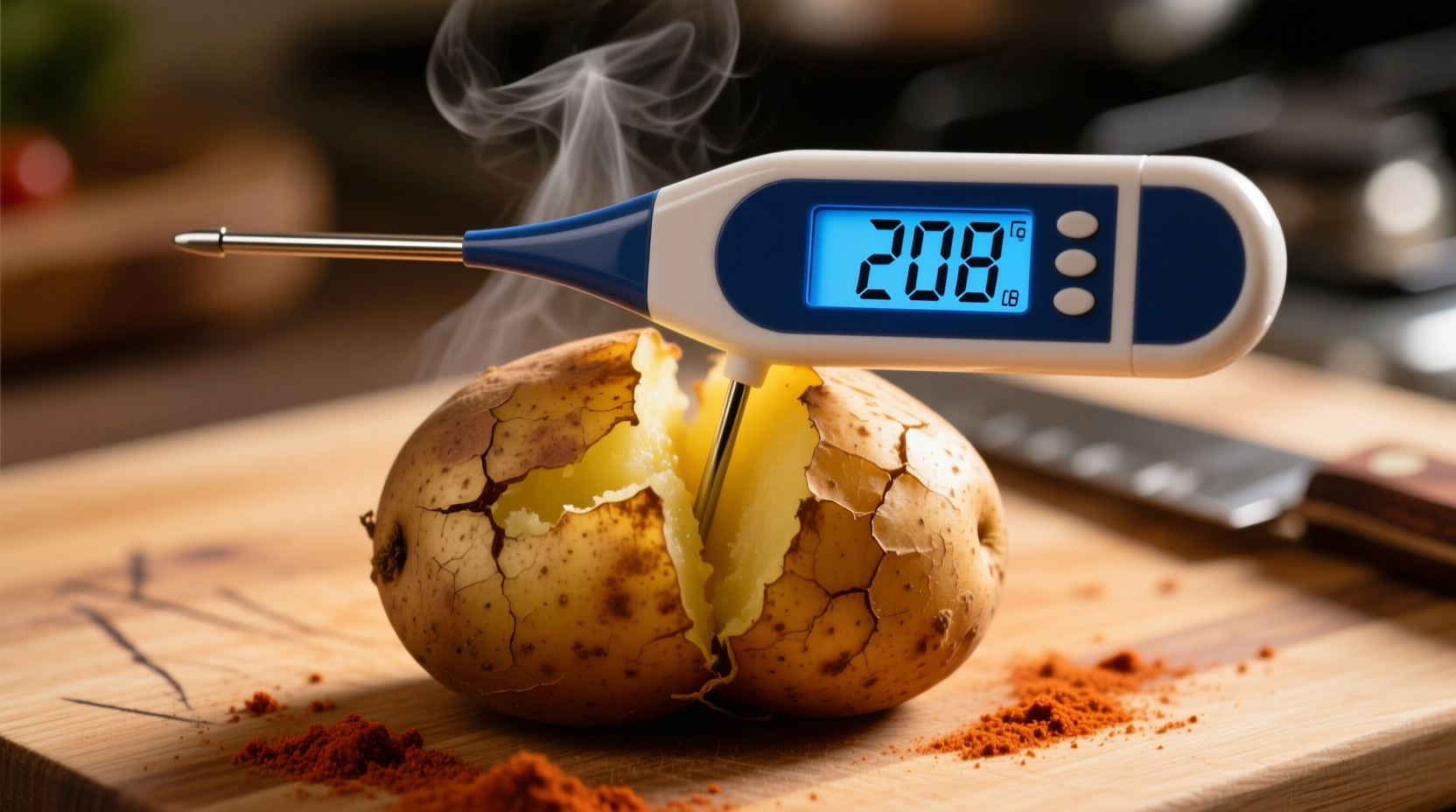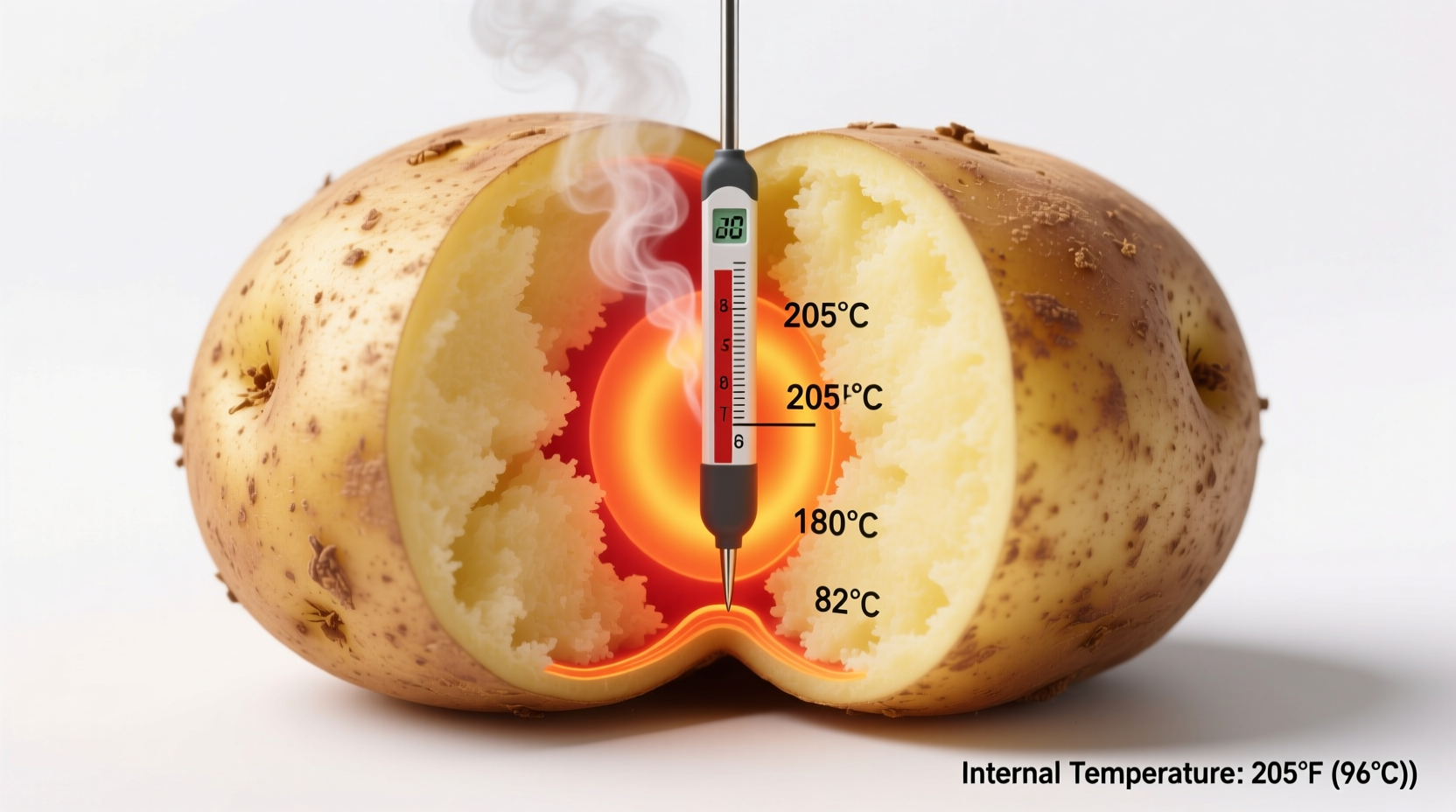The perfect internal temperature for a fully cooked baked potato is 205°F to 210°F (96°C to 99°C). This precise range ensures fluffy, fully gelatinized starches while eliminating any risk of undercooked texture. Measuring with a reliable instant-read thermometer inserted into the thickest part of the potato provides the most accurate doneness assessment.
Have you ever cut into a baked potato only to find a dense, undercooked center? Or wasted time waiting for that perfect fluffy texture? Getting the internal temperature right transforms your baked potato from mediocre to magnificent. In this guide, you'll discover exactly what temperature guarantees perfect results every time, plus practical techniques professional chefs use to achieve consistently flawless baked potatoes.
Why Temperature Matters More Than Time
Baking times vary significantly based on potato size, oven accuracy, and starting temperature. Relying solely on time leads to inconsistent results. The internal temperature for baked potato provides an objective measure of doneness that accounts for all variables. At 205°F-210°F, potato starches have fully gelatinized, creating that signature light, fluffy interior while maintaining structural integrity.
| Temperature Range | Texture Result | Starch Transformation |
|---|---|---|
| <190°F (88°C) | Dense, undercooked | Minimal gelatinization |
| 190-200°F (88-93°C) | Firm but edible | Partial gelatinization |
| 205-210°F (96-99°C) | Perfectly fluffy | Complete gelatinization |
| >215°F (102°C) | Dry, crumbly | Excessive moisture loss |
How to Accurately Measure Internal Temperature
Proper temperature measurement technique makes all the difference:
- Use an instant-read digital thermometer for fastest, most accurate results
- Insert probe into the thickest part of the potato, avoiding any foil
- Check multiple spots in larger potatoes (8+ ounces)
- Allow 10-15 seconds for reading stabilization
According to the USDA Food Safety and Inspection Service, while 165°F is the minimum safe temperature for most foods, potatoes require higher temperatures for optimal texture. The USDA specifically notes that baked potatoes should reach temperatures well above 165°F to achieve proper doneness.

Factors Affecting Baking Time and Temperature
Several variables influence how quickly your potato reaches the ideal internal temperature for baked potato:
Potato Characteristics
- Size: A 6-ounce potato typically needs 45-55 minutes at 400°F, while a 12-ounce potato requires 65-75 minutes
- Variety: Russets (Idaho potatoes) reach optimal texture at 205-210°F, while denser sweet potatoes need 200-205°F
- Starting temperature: Refrigerated potatoes add 10-15 minutes to baking time compared to room temperature
Oven Conditions
- Oven accuracy: Many home ovens vary by ±25°F from set temperature
- Rack position: Middle rack provides most even heating
- Convection vs. conventional: Convection ovens reduce baking time by 20-25%
Visual and Tactile Doneness Indicators
While temperature is most reliable, these secondary indicators confirm proper doneness:
- Skin appearance: Crisp, slightly wrinkled with golden-brown patches
- Squeeze test: Gently press sides - should yield slightly with soft resistance
- Steam release: Visible steam when inserting thermometer
- Internal color: Uniform creamy white without translucent areas
Troubleshooting Common Temperature Issues
Undercooked Center (Below 200°F)
Solution: Return to oven and check every 5 minutes. For faster results, wrap loosely in microwave-safe wrap and microwave for 1-2 minutes before returning to oven.
Overcooked/Dry Potato (Above 215°F)
Solution: Reduce oven temperature by 25°F next time. For immediate salvage, slice open and mix in 1-2 tablespoons of warm milk or cream before serving.
Inconsistent Temperature Readings
Solution: Check multiple spots. Large potatoes often have temperature variations of 10-15°F between center and edges. Always target the coolest reading when determining doneness.
Storage and Reheating Guidelines
Properly stored baked potatoes maintain quality for 3-5 days:
- Cooling: Allow to cool at room temperature for no more than 2 hours before refrigerating
- Storage: Place in airtight container without toppings
- Reheating: Restore optimal texture by reheating to 165°F internal temperature using these methods:
| Method | Time | Target Temp | Texture Result |
|---|---|---|---|
| Oven (400°F) | 15-20 min | 165°F | Crispiest skin |
| Air Fryer (380°F) | 10-12 min | 165°F | Balanced texture |
| Microwave | 2-3 min | 165°F | Softest texture |
Remember that reheated potatoes won't reach the ideal 205-210°F range for initial baking, as this would cause excessive moisture loss. The food safety standard of 165°F is sufficient for reheated potatoes.
Professional Chef Tips for Perfect Results
Implement these techniques used in professional kitchens:
- Pre-bake preparation: Prick skin 8-10 times with fork to allow steam escape
- Oil application: Rub with oil only after baking for crispier skin (oil before baking can trap moisture)
- Resting period: Allow 5 minutes after baking for temperature equalization
- Temperature verification: Check multiple potatoes when baking in batches
Food science research from the University of California Davis Department of Food Science & Technology confirms that potato starch gelatinization occurs between 170°F-190°F, but complete transformation for optimal texture requires the higher 205°F-210°F range. This explains why potatoes can be technically safe (above 165°F) but still disappointingly dense.
Special Considerations for Different Cooking Methods
The ideal internal temperature for baked potato remains consistent regardless of cooking method, but techniques vary:
Conventional Oven Baking
Place directly on oven rack with baking sheet below to catch drips. No foil needed - it traps steam and creates boiled texture.
Air Fryer Method
Cook at 400°F for 35-45 minutes, checking temperature at 30 minutes. Smaller capacity means single-layer cooking for even results.
Grill Preparation
Use indirect heat at 375°F-400°F. Wrap in foil only if cooking directly over flames. Target same 205°F-210°F internal temperature.
Slow Cooker Technique
While not traditional baking, slow cookers can reach proper temperature. Check after 4 hours on high or 7 hours on low. May lack crispy skin but achieves proper internal temperature.
For food safety, the FDA Food Code specifies that potentially hazardous foods like potatoes must be held above 135°F or below 41°F to prevent bacterial growth. When serving baked potatoes with fillings, maintain proper temperature control to avoid foodborne illness risks.











 浙公网安备
33010002000092号
浙公网安备
33010002000092号 浙B2-20120091-4
浙B2-20120091-4